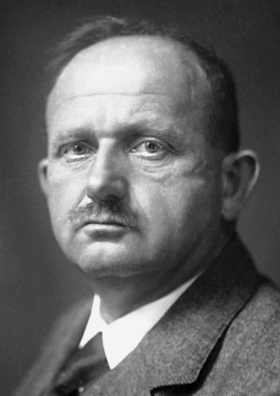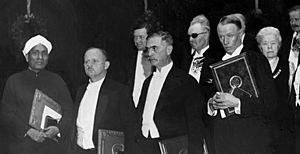Hans Fischer facts for kids
Quick facts for kids
Hans Fischer
|
|
|---|---|
 |
|
| Born | 27 July 1881 Höchst on Main, Hesse-Nassau, Kingdom of Prussia, German Empire
|
| Died | 31 March 1945 (aged 63) Munich, Gau Munich-Upper Bavaria, Nazi Germany
|
| Alma mater | University of Lausanne University of Marburg |
| Known for | Chlorophyll Haemin Fischer–Fink synthesis |
| Awards | Liebig Medal (1929) Nobel Prize for Chemistry (1930) Davy Medal (1937) |
| Scientific career | |
| Fields | Chemistry |
| Institutions | University of Innsbruck, University of Vienna, Technical University of Munich |
| Doctoral advisor | Theodor Zincke |
| Other academic advisors | Emil Fischer |
| Doctoral students |
|
Hans Fischer (German pronunciation: [ˈhans ˈfɪʃɐ]; 27 July 1881 – 31 March 1945) was a German organic chemist and the recipient of the 1930 Nobel Prize for Chemistry "for his researches into the constitution of haemin and chlorophyll and especially for his synthesis of haemin."
Contents
Biography
Early years
Fischer was born on July 27, 1881, in Höchst on river Main, now a city district of Frankfurt located in Germany. His parents were Dr. Eugen Fischer, Director of the firm of Kalle & Co, Wiesbaden, and Privatdozent at the Technical High School, Stuttgart, and Anna Herdegen was his mother. He went to a primary school in Stuttgart, and later to the "Humanistisches Gymnasium" in Wiesbaden, matriculating in 1899. He read chemistry and medicine, first at the University of Lausanne and then at Marburg. He graduated in 1904 obtaining his chemistry degree, 2 years later in 1906 he licensed for medicine and in 1908 he qualified for his M.D. which he applied to the University of Munich.
Career
He worked first at a Medical Clinic in Munich and then at the First Berlin Chemical Institute under Emil Fischer. He returned to Munich in 1911 and qualified as lecturer on internal medicine one year later. In 1913, he became a lecturer in physiology at the Physiological Institute in Munich. In 1916, he became Professor of Medical Chemistry at the University of Innsbruck and from there he went to the University of Vienna in 1918.
From 1921 until his death, he held the position of Professor of Organic Chemistry at the Technical University of Munich.
Fischer's scientific work was mostly concerned with the investigation of the pigments in blood, bile, and also chlorophyll in leaves, as well as with the chemistry of pyrrole from which these pigments are derived. Of special importance was his synthesis of bilirubin and haemin. He received many honors for this work, and received the Nobel Prize in 1930. The lunar crater Fischer was named after him (and Hermann Emil Fischer) in 1976. Hans Fisher had mapped the composition of a hem group. In 1929 Fischer succeeded in producing the substance and proving that its ring has a central atom of iron, as he also continued studying other pigmented substances of a biological importance of biochemistry such as chlorophyll, the color that plays part in a plants photosynthesis. Fischer also unraveled the bile pigments biliverdin (which causes the yellowish color characteristic of bruised skin) and bilirubin (which yellows skin in jaundice cases), and synthesized them in 1942 and 1944, successively. He conducted microanalyses of more than 60,000 chemical substance, and had won the Nobel Prize for Chemistry in 1930. The person that sparked Fischer's interest was von Muller, his former professor and supervisor whom interests were in pyrrole pigments by inviting Fischer to work with him at the well-known Second Medical Clinic in Munich in 1910. Under Muller, he began to examine the composition of the bile pigment bilirubin, something he would continue to be engaged in during the decades that followed. Fischer's succession also came with difficulty's as many of his experiments seemed to have failed but with time Fischer was able to perfect his acknowledgement with is failed attempts.
Personal life
Fischer married Wiltrud Haufe around his 50's in the year 1935. Fischer was a man whom dedicated almost "exclusively" to his work. .....
Honours
- Fellow of the Academy of Sciences Leopoldina (1919)
- Privy Councillor (1925)
- Liebig Memorial Medal (1929)
- Nobel Prize for Chemistry (1930)
- Honorary doctorate, Harvard University (1936)
- Davy Medal of the Royal Society of London (1937)
$
See also
 In Spanish: Hans Fischer para niños
In Spanish: Hans Fischer para niños


